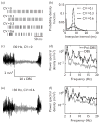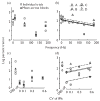Tremor varies as a function of the temporal regularity of deep brain stimulation
- PMID: 18388746
- PMCID: PMC2586391
- DOI: 10.1097/WNR.0b013e3282f9e45e
Tremor varies as a function of the temporal regularity of deep brain stimulation
Abstract
The frequency of stimulation is one of the primary factors determining the effectiveness of deep brain stimulation (DBS) in relieving tremor. DBS efficacy, however, may depend not only on the average frequency of stimulation, but also on the temporal pattern of stimulation. We conducted intraoperative measurements of the effect of temporally irregular DBS (nonconstant interpulse intervals) on tremor. As the coefficient of variation of irregular high frequency DBS trains increased, they became less effective at reducing tremor (mixed effects regression model, P<0.04). These data provide evidence that the effects of DBS are dependent not only on the average frequency of DBS, but also on the regularity of the temporal spacing of DBS pulses.
Figures


Similar articles
-
Stimulus features underlying reduced tremor suppression with temporally patterned deep brain stimulation.J Neurophysiol. 2012 Jan;107(1):364-83. doi: 10.1152/jn.00906.2010. Epub 2011 Oct 12. J Neurophysiol. 2012. PMID: 21994263 Free PMC article.
-
Effects of ramped-frequency thalamic deep brain stimulation on tremor and activity of modeled neurons.Clin Neurophysiol. 2020 Mar;131(3):625-634. doi: 10.1016/j.clinph.2019.11.060. Epub 2019 Dec 26. Clin Neurophysiol. 2020. PMID: 31978847 Free PMC article.
-
Short pauses in thalamic deep brain stimulation promote tremor and neuronal bursting.Clin Neurophysiol. 2016 Feb;127(2):1551-1559. doi: 10.1016/j.clinph.2015.07.034. Epub 2015 Aug 20. Clin Neurophysiol. 2016. PMID: 26330131 Free PMC article.
-
Deep brain stimulation for vocal tremor: a comprehensive, multidisciplinary methodology.Neurosurg Focus. 2015 Jun;38(6):E6. doi: 10.3171/2015.3.FOCUS1537. Neurosurg Focus. 2015. PMID: 26030706 Review.
-
Deep brain stimulation and tremor.Neurotherapeutics. 2008 Apr;5(2):331-8. doi: 10.1016/j.nurt.2008.01.004. Neurotherapeutics. 2008. PMID: 18394574 Free PMC article. Review.
Cited by
-
Improved efficacy of temporally non-regular deep brain stimulation in Parkinson's disease.Exp Neurol. 2013 Jan;239:60-7. doi: 10.1016/j.expneurol.2012.09.008. Epub 2012 Sep 27. Exp Neurol. 2013. PMID: 23022917 Free PMC article.
-
Stereotactic implantation of deep brain stimulation electrodes: a review of technical systems, methods and emerging tools.Med Biol Eng Comput. 2010 Jul;48(7):611-24. doi: 10.1007/s11517-010-0633-y. Epub 2010 Jun 2. Med Biol Eng Comput. 2010. PMID: 20517711 Review.
-
Stimulus features underlying reduced tremor suppression with temporally patterned deep brain stimulation.J Neurophysiol. 2012 Jan;107(1):364-83. doi: 10.1152/jn.00906.2010. Epub 2011 Oct 12. J Neurophysiol. 2012. PMID: 21994263 Free PMC article.
-
The Therapeutic Frequency Profile of Subthalamic Nucleus Deep Brain Stimulation in Rats Is Shaped by Antidromic Spike Failure.J Neurosci. 2023 Jul 5;43(27):5114-5127. doi: 10.1523/JNEUROSCI.1798-22.2023. Epub 2023 Jun 16. J Neurosci. 2023. PMID: 37328290 Free PMC article.
-
Patient-Specific Electric Field Simulations and Acceleration Measurements for Objective Analysis of Intraoperative Stimulation Tests in the Thalamus.Front Hum Neurosci. 2016 Nov 25;10:577. doi: 10.3389/fnhum.2016.00577. eCollection 2016. Front Hum Neurosci. 2016. PMID: 27932961 Free PMC article.
References
-
- Ushe M, Mink JW, Revilla FJ, Wernle A, Schneider Gibson P, McGee-Minnich L, et al. Effect of stimulation frequency on tremor suppression in essential tremor. Mov Disord. 2004;19:1163–1168. - PubMed
-
- Benabid AL, Pollak P, Gervason C, Hoffmann D, Gao DM, Hommel M, et al. Long-term suppression of tremor by chronic stimulation of the ventral intermediate thalamic nucleus. Lancet. 1991;337:403–406. - PubMed
-
- Kuncel AM, Cooper SE, Wolgamuth BR, Clyde MA, Snyder SA, Montgomery EB, Jr, et al. Clinical response to varying the stimulus parameters in deep brain stimulation for essential tremor. Mov Disord. 2006;21:1920–1928. - PubMed
-
- Montgomery EB, Jr, Baker KB, Kinkel RP, Barnett G. Chronic thalamic stimulation for the tremor of multiple sclerosis. Neurology. 1999;53:625–628. - PubMed
-
- Moro E, Esselink RJ, Xie J, Hommel M, Benabid AL, Pollak P. The impact on Parkinson’s disease of electrical parameter settings in stn stimulation. Neurology. 2002;59:706–713. - PubMed
Publication types
MeSH terms
Grants and funding
LinkOut - more resources
Full Text Sources
Other Literature Sources
Medical
Research Materials

